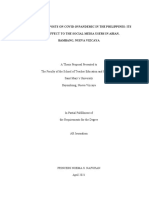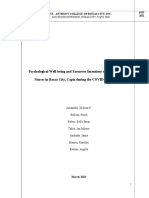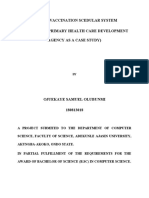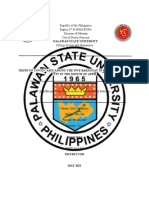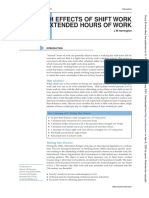Reballos Et Al. SPATIAL DISTRIBUTION
Reballos Et Al. SPATIAL DISTRIBUTION
Uploaded by
Christopher Allan ReballosCopyright:
Available Formats
Reballos Et Al. SPATIAL DISTRIBUTION
Reballos Et Al. SPATIAL DISTRIBUTION
Uploaded by
Christopher Allan ReballosOriginal Description:
Original Title
Copyright
Available Formats
Share this document
Did you find this document useful?
Is this content inappropriate?
Copyright:
Available Formats
Reballos Et Al. SPATIAL DISTRIBUTION
Reballos Et Al. SPATIAL DISTRIBUTION
Uploaded by
Christopher Allan ReballosCopyright:
Available Formats
SPATIAL DISTRIBUTION OF COVID-19 IN PASAY CITY, METRO MANILA BETWEEN
JANUARY AND MARCH 2021: AN EPIDEMIOLOGICAL STUDY
A.G. Jaramillo1, M.J.C.P. Flores1, J.P. Garcia1, E.A.O. Quines1, M.B. Tatad1,
and C.A.F. Reballos MSc2
1
College of Medical Technology, San Juan de Dios Educational Foundation, Inc.
2
General Education Department, San Juan de Dios Educational Foundation, Inc.
Abstract
Pasay City, in Metro Manila, Philippines, was previously declared under a state of calamity, with
14 barangays in critical areas after COVID cases surged in 2020. At the onset of 2021, it had been the
second largest number of cases; however, the city government declared a 300% rise in cases in February
2021. After the alpha and beta variants spread in March and August 2020, the delta variant spread in the
Philippines in early 2021. Thus, the study aimed to determine the spatial distribution of incidence of
COVID-19 in Pasay City from January to March 2021 and use it as the basis for COVID surveillance of
the city government. This observational study used Pasay City Local Government' City Health Unit
Data, in conjunction with the Department of Health's (DOH's) daily census, in different Pasay City's
Clusters (PCCs). Reports of new cases, recoveries, and deaths between January and March 2021 were
recorded and analyzed. Based on the findings, there was a marked significant increase of new COVID
cases (p<0.0000) in all PCCs from mid-January to mid-March 2021. More than 500 reported new cases
were observed in Leveriza, Dr. EM Lagrosa, and Malibay Clusters. COVID recoveries in all PCCs are
boundless, except in Kalayaan Cluster, with a greater new cases-recoveries ratio. COVID death-related
status was notable. During the study period, more than 100 deaths were reported in most PCCs, except
for Kalayaan, Villamor, and Dona Nena Clusters. Despite the number, underreporting testing backlogs,
delays, and stating errors, as well as invalidating for recoveries and fatalities, could result in
unintentionally low case counts, recoveries, and deaths. Among the PCCs, San Isidro, M. De La Cruz,
and Dr. EM Lagrosa had the highest reported new cases, recoveries, and deaths. Among the rest of the
PCCs, Doña Nena Cluster has the lowest reports. This finding was related to the population size,
mobility, the number of barangays included within the clusters, and the presence of establishments and
transportation hubs. It was found that the overall relative risk for acquiring SARS-COV-2 virus of 0.367
(p<0.05) in February 2021 increased to 0.469 (p<0.05) in March 2021. However, at the end of March
2021, there is no significant difference in the increase of new COVID-19 cases between PCCs, except
between Malibay and San Pablo Clusters (p=0.0408); and Villamor and Kalayaan Clusters (p=0.0046).
Malibay and Villamore were found to have significant increased over San Pablo and Kalayaan,
respectively. Residential structure and population size interplay in the significant difference of increase
in cases over the said PCCs. Both the national and local policy recommendations of hand washing,
social distancing, and the use of face masks and face shields and the research data don't complement. In
order to combat the spread into neighboring PCCs, the city administration should take aggressive and
daring measures intended to stop a sharp rise in the number of COVID cases in the future. Regardless,
the COVID surveillance in Pasay City should demand a reassessment and apply specific interventions
appropriate for the PCCs.
Keywords: coronavirus, epidemiology, Pasay City,
You might also like
- Is.3786 2022Document18 pagesIs.3786 2022hamidNo ratings yet
- Example - PR 2Document14 pagesExample - PR 2hannah jean NaldoNo ratings yet
- Spatial and Epidemiological Analyses of COVID-19 in The Older Population of The Brazilian Amazon RegionDuring 2020Document6 pagesSpatial and Epidemiological Analyses of COVID-19 in The Older Population of The Brazilian Amazon RegionDuring 2020marcusjabaNo ratings yet
- Research Paper - Datiles - Javier - Tobias - Vasquez - Bsn2aDocument9 pagesResearch Paper - Datiles - Javier - Tobias - Vasquez - Bsn2aMari Sheanne M. VasquezNo ratings yet
- RIVERA, Jerico - ANTHRO179 - ADVOCACYPROPOSALDocument17 pagesRIVERA, Jerico - ANTHRO179 - ADVOCACYPROPOSALJerico RiveraNo ratings yet
- Morbidity and Mortality Rate of Dengue Cases in Valencia City, Bukidnon 2015-2019Document54 pagesMorbidity and Mortality Rate of Dengue Cases in Valencia City, Bukidnon 2015-2019bronolamiraNo ratings yet
- Tabuk City National High SchoolDocument14 pagesTabuk City National High SchoolMark NerbNo ratings yet
- Exploring The Nexus Between Medical Geography and Covid-19 Control in NigeriaDocument16 pagesExploring The Nexus Between Medical Geography and Covid-19 Control in NigeriaHabib IbrahimNo ratings yet
- Background of The StudyDocument4 pagesBackground of The Studychharlzzzzieeekiee minyungggggNo ratings yet
- Social Media Posts On Covid-19 Pandemic in The Philippines: Its Panic Effect To The Social Media Users in Abian, Bambang, Nueva VizcayaDocument32 pagesSocial Media Posts On Covid-19 Pandemic in The Philippines: Its Panic Effect To The Social Media Users in Abian, Bambang, Nueva VizcayaZemaia Sen100% (1)
- Final Group A BSN 3A 2Document91 pagesFinal Group A BSN 3A 2ATEHAN BORDSNo ratings yet
- Hawidlaum 1Document10 pagesHawidlaum 1Tranquilina ReyesNo ratings yet
- Samuel CHAPTER 1 CorrectionDocument10 pagesSamuel CHAPTER 1 CorrectionNaomi AkinwumiNo ratings yet
- ThecorrelationofpopulationpopulationdensityageandsextothenumberofconfirmedcasesofCOVID 19amonglocalgovernmentunitsintheNationalCapitalRegionDocument8 pagesThecorrelationofpopulationpopulationdensityageandsextothenumberofconfirmedcasesofCOVID 19amonglocalgovernmentunitsintheNationalCapitalRegionkayc33264No ratings yet
- Narrative ReportDocument56 pagesNarrative ReportJesus MananganNo ratings yet
- Levels of Awareness and Preventive Measures of Shs Students On Novel Coronavirus (Covid-19)Document61 pagesLevels of Awareness and Preventive Measures of Shs Students On Novel Coronavirus (Covid-19)Steel BustriaNo ratings yet
- Philippines: Measles Outbreak: Emergency AppealDocument11 pagesPhilippines: Measles Outbreak: Emergency AppealPhilippe Ceasar C. BascoNo ratings yet
- Epidemiological Analysis of COVID-19 Cases in Native Amazonian Communities From PeruDocument12 pagesEpidemiological Analysis of COVID-19 Cases in Native Amazonian Communities From PeruyanettNo ratings yet
- Artigo CovidDocument6 pagesArtigo Covidilano oliveiraNo ratings yet
- Mycoplasma Pneumoniae in Colombian Pediatric Patients Post-PandemicDocument3 pagesMycoplasma Pneumoniae in Colombian Pediatric Patients Post-PandemicJUAN ESTEBAN FONTALVO VANEGASNo ratings yet
- Aguado, Emma Angelica B. Section 80 Summative AssessmentDocument3 pagesAguado, Emma Angelica B. Section 80 Summative AssessmentEMMANo ratings yet
- Sample Thesis Ch1-3Document34 pagesSample Thesis Ch1-3Paul John RicoNo ratings yet
- Qiu2020 Article ImpactsOfSocialAndEconomicFactDocument46 pagesQiu2020 Article ImpactsOfSocialAndEconomicFactReni Wahyu NoviantiNo ratings yet
- Palawan State UniversityDocument20 pagesPalawan State UniversityMengmeng GinfabNo ratings yet
- Babesiosis ArticleDocument5 pagesBabesiosis Articlemuomahrosa2020No ratings yet
- NCOV Analysis GARNICA YU MAPRANGALADocument12 pagesNCOV Analysis GARNICA YU MAPRANGALAJun Gabriel GarnicaNo ratings yet
- NOGUEIRA Et Al (2022) - COVID-19's Intra-Urban Inequalities and Social Vulnerability in A Medium-Sized CityDocument10 pagesNOGUEIRA Et Al (2022) - COVID-19's Intra-Urban Inequalities and Social Vulnerability in A Medium-Sized CityJoão Pedro CaetanoNo ratings yet
- Ged104 Module1 PaperDocument3 pagesGed104 Module1 PaperAdolf HitlerNo ratings yet
- Spatial and Spatio-Temporal Epidemiology: Jack Cordes, Marcia C. CastroDocument8 pagesSpatial and Spatio-Temporal Epidemiology: Jack Cordes, Marcia C. CastroTALITA SOUZANo ratings yet
- Review of Related LiteratureDocument16 pagesReview of Related LiteratureHavier EsparagueraNo ratings yet
- Advpub JE20200148Document9 pagesAdvpub JE20200148STIKes Santa Elisabeth MedanNo ratings yet
- C.Manineng Et AlDocument13 pagesC.Manineng Et AlPatrick LamaNo ratings yet
- Chapter I IiDocument26 pagesChapter I IiAron JaroNo ratings yet
- Rodriguez Jimenez2020Document4 pagesRodriguez Jimenez2020winnickimariusz96No ratings yet
- Group Assignment Population EconomicsDocument7 pagesGroup Assignment Population EconomicsSayed Abdullah Shah SadaatNo ratings yet
- Coronavirus Disease (COVID-19) PandemicDocument3 pagesCoronavirus Disease (COVID-19) PandemicRobin WongNo ratings yet
- Trend Analysis of Exponential Increase of COVID-19 Cases in Pakistan: An InterpretationDocument21 pagesTrend Analysis of Exponential Increase of COVID-19 Cases in Pakistan: An InterpretationBongoNo ratings yet
- Socioeconomic Inequalities in COVID-19 Vaccination and Infection in Adults, Catalonia, SpainDocument10 pagesSocioeconomic Inequalities in COVID-19 Vaccination and Infection in Adults, Catalonia, SpainMaría Jesús Maass OleaNo ratings yet
- Exceso de Mortalidad en Mexico LANCETDocument15 pagesExceso de Mortalidad en Mexico LANCETJM LNo ratings yet
- 4529 19778 1 PBDocument9 pages4529 19778 1 PBAkhmad Rianto SaadNo ratings yet
- En - 2308 0531 RFMH 22 03 650Document3 pagesEn - 2308 0531 RFMH 22 03 650jhonyNo ratings yet
- COVID Catastrophe: Consequences of Societal ShutdownsDocument27 pagesCOVID Catastrophe: Consequences of Societal ShutdownsMaine Policy Institute100% (1)
- Coronavirus Disease (COVID-19) Pandemic and Pakistan Limitations and GapsDocument11 pagesCoronavirus Disease (COVID-19) Pandemic and Pakistan Limitations and GapsRai Ahsan KharalNo ratings yet
- Contemporary World by JoelDocument2 pagesContemporary World by Joelmae joyNo ratings yet
- March 2021 Seminar ReflectionDocument4 pagesMarch 2021 Seminar Reflectionapi-530019165No ratings yet
- A Comparative Study On The Knowledge, Attitude, and Practices (Kap) On The Preventive Measures Against Covid-19Document47 pagesA Comparative Study On The Knowledge, Attitude, and Practices (Kap) On The Preventive Measures Against Covid-19Genel ZuñigaNo ratings yet
- Research Paper Chapter 1 3Document34 pagesResearch Paper Chapter 1 3Lyca jean PascuaNo ratings yet
- Final Copy Covid Practicum 1Document9 pagesFinal Copy Covid Practicum 1api-449184986No ratings yet
- Coronavirus Disease 2019 (COVID-19) : A Cross-Sectional Survey of The Knowledge, Attitudes, Practices (KAP) and Misconceptions in The General Population of Katsina State, NigeriaDocument14 pagesCoronavirus Disease 2019 (COVID-19) : A Cross-Sectional Survey of The Knowledge, Attitudes, Practices (KAP) and Misconceptions in The General Population of Katsina State, NigeriaUMYU Journal of Microbiology Research (UJMR)No ratings yet
- Factors Affecting The Perceptions of The High School Students of Montessori de San Ildefonso Yet To Be Vaccinated Academic Year 2021 2022Document66 pagesFactors Affecting The Perceptions of The High School Students of Montessori de San Ildefonso Yet To Be Vaccinated Academic Year 2021 2022Aliah Jashel Dela CruzNo ratings yet
- Philippines: Situation Report 31Document9 pagesPhilippines: Situation Report 31Alven T BactadNo ratings yet
- NSG 198 Chapter 1Document6 pagesNSG 198 Chapter 1Nadja JamilahNo ratings yet
- Mm6905e1 HDocument7 pagesMm6905e1 HShuvo H AhmedNo ratings yet
- Flower 2021Document2 pagesFlower 2021kritisinha0010No ratings yet
- Visual AbstractDocument1 pageVisual Abstractedgard capristan rojasNo ratings yet
- Wastewater-based epidemiology A Brazilian SARS-COV-2Document9 pagesWastewater-based epidemiology A Brazilian SARS-COV-2Yasodhara CapellaNo ratings yet
- Penha2020 The Pandemic and Its Ethno-Spatial Disparities Salvador Bahia BrazilDocument8 pagesPenha2020 The Pandemic and Its Ethno-Spatial Disparities Salvador Bahia BrazilGabriel TaylorNo ratings yet
- Thesis Body Final Copy To SubmitDocument100 pagesThesis Body Final Copy To SubmitR ArcegaNo ratings yet
- Artigo 3 - IPMDocument2 pagesArtigo 3 - IPMisabellafrizzera44No ratings yet
- Anti-vaxxers: How to Challenge a Misinformed MovementFrom EverandAnti-vaxxers: How to Challenge a Misinformed MovementRating: 4 out of 5 stars4/5 (7)
- Coronavirus: Arm Yourself With Facts: Symptoms, Modes of Transmission, Prevention & TreatmentFrom EverandCoronavirus: Arm Yourself With Facts: Symptoms, Modes of Transmission, Prevention & TreatmentRating: 5 out of 5 stars5/5 (1)
- Est MicroprojectDocument14 pagesEst Microprojectsdargopatil11No ratings yet
- B.ing Materi 2Document21 pagesB.ing Materi 20161A Umrotul AiniNo ratings yet
- Synklino Presentation For Candidated Best Talent JUNE 2023Document19 pagesSynklino Presentation For Candidated Best Talent JUNE 2023ersoycolakNo ratings yet
- Questions BasedDocument69 pagesQuestions Baseds007750No ratings yet
- 063 Degree 6 Nos 22-25 1111Document40 pages063 Degree 6 Nos 22-25 1111Esperant Kilonda100% (2)
- Congenital Heart DefectsDocument16 pagesCongenital Heart DefectsLara TomašićNo ratings yet
- Quiz Lesion LocalizationDocument10 pagesQuiz Lesion LocalizationGhazi Uddin AhmedNo ratings yet
- Thesis Statement For Salem Witch TrialsDocument8 pagesThesis Statement For Salem Witch TrialsScott Bou100% (1)
- Perceptions About Childhood Vaccinations: Pam CooperDocument19 pagesPerceptions About Childhood Vaccinations: Pam CooperLancasterOnlineNo ratings yet
- 01 LactobacillusDocument16 pages01 LactobacillusPravesh NiraulaNo ratings yet
- MeaslesDocument14 pagesMeaslesCHALIE MEQUNo ratings yet
- Temporomandibular Joint Clinical AnatomyDocument43 pagesTemporomandibular Joint Clinical AnatomyPriyaNo ratings yet
- Minutes) PRE TESTDocument13 pagesMinutes) PRE TESTRanes AndyNo ratings yet
- Healthmeans 3 Interview Transcripts From The Eczema Psoriasis Skin Disease MasterclassDocument37 pagesHealthmeans 3 Interview Transcripts From The Eczema Psoriasis Skin Disease MasterclasskoponicNo ratings yet
- DR Mercola - Phospholipids - A Hidden Superpower For Your HealthDocument9 pagesDR Mercola - Phospholipids - A Hidden Superpower For Your Healthguy777No ratings yet
- Self-Quiz Unit 7 - Attempt Review - 2Document5 pagesSelf-Quiz Unit 7 - Attempt Review - 2yeehawbuddy707No ratings yet
- Neonatal Fever Clinical PathwayDocument55 pagesNeonatal Fever Clinical PathwayAdvocateforPedsNo ratings yet
- Rle 217... Typology of Nursing Problems in Family Nursing Practice MaglayaDocument6 pagesRle 217... Typology of Nursing Problems in Family Nursing Practice MaglayaMakspeyn del Valle - MoonNo ratings yet
- DHEA, Magnesium & The Fountain of YouthDocument5 pagesDHEA, Magnesium & The Fountain of YouthMichael Gordan100% (1)
- Preterm Complications..Document89 pagesPreterm Complications..UdayBhaskar Chintha100% (1)
- 10 Surgical Considerations in Older Adults - Ethics and Palliative CareDocument13 pages10 Surgical Considerations in Older Adults - Ethics and Palliative CareMyrtle Yvonne RagubNo ratings yet
- Health Effects of Shift Work and Extended Hours of WorkDocument5 pagesHealth Effects of Shift Work and Extended Hours of Workvideo seru25No ratings yet
- 11 BreastDocument22 pages11 BreastMohammed GhozzNo ratings yet
- Jurnal DM 2Document14 pagesJurnal DM 2Ayu wismaya DewiNo ratings yet
- NCM 116 Module 3 and 4 PDFDocument183 pagesNCM 116 Module 3 and 4 PDF7rvcnnxk88No ratings yet
- Detailed Brief of NPHCEDocument6 pagesDetailed Brief of NPHCEMETALX 100No ratings yet
- Dr. (MRS.) Arpana Pareek: Reader, Dept of Repertory Smt. KBAHMC, ChandwadDocument35 pagesDr. (MRS.) Arpana Pareek: Reader, Dept of Repertory Smt. KBAHMC, ChandwadRahul PandeyNo ratings yet
- Dengue ReviewerDocument3 pagesDengue ReviewerSidney Bon LuceroNo ratings yet
- A Review of Orthodontic Indices: DR Alka Gupta, DR Rabindra Man ShresthaDocument7 pagesA Review of Orthodontic Indices: DR Alka Gupta, DR Rabindra Man ShresthaJasmine Pang100% (1)









